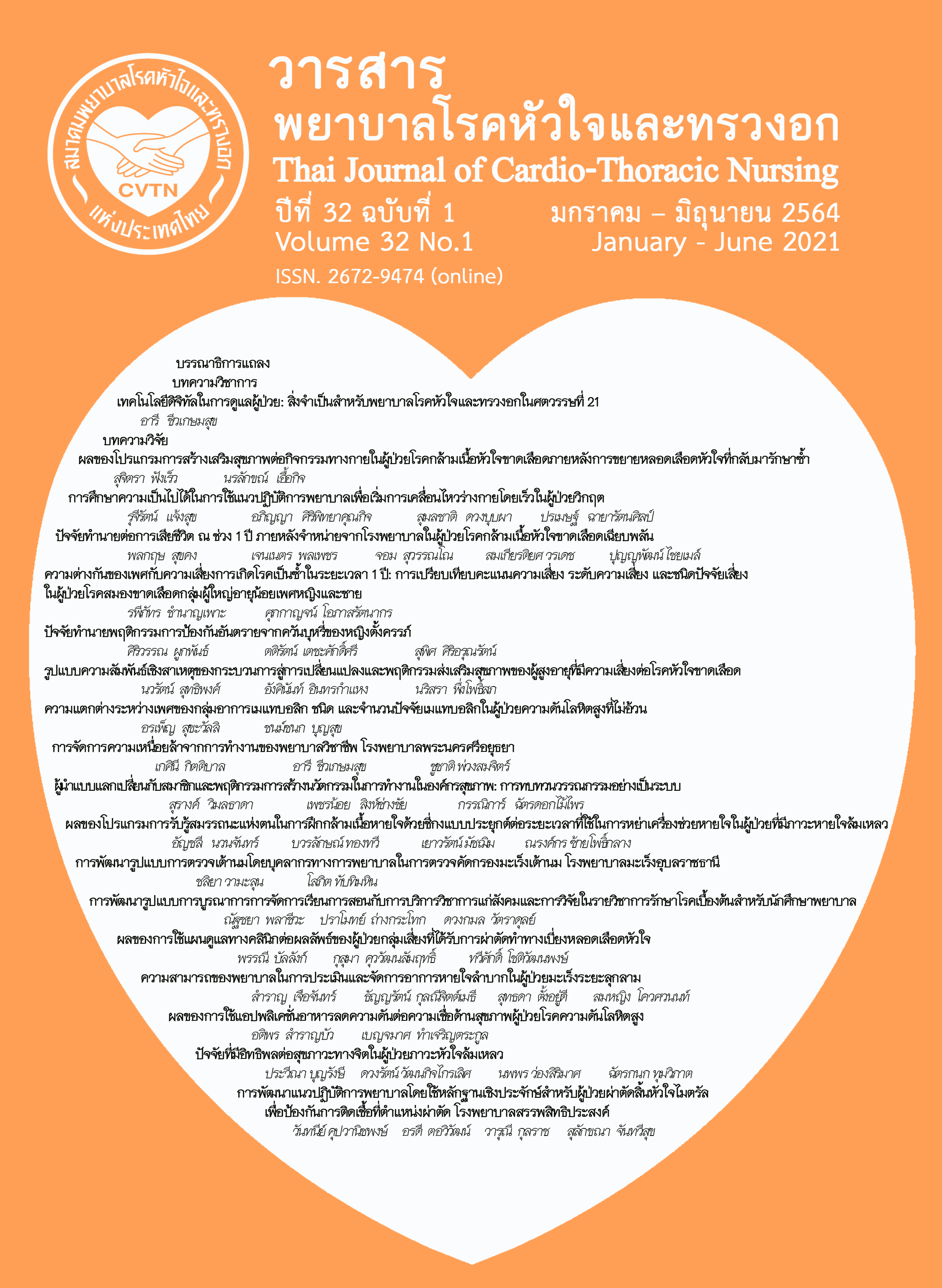ความแตกต่างระหว่างเพศของกลุ่มอาการเมแทบอลิก ชนิด และจำนวนปัจจัย เมแทบอลิกในผู้ป่วยความดันโลหิตสูงที่ไม่อ้วน
คำสำคัญ:
กลุ่มอาการเมแทบอลิก, ความดันโลหิตสูง, ความแตกต่างทางเพศบทคัดย่อ
การวิจัยเชิงบรรยายของความสัมพันธ์เชิงเปรียบเทียบ มีวัตถุประสงค์ เพื่อศึกษาเปรียบเทียบความชุกกลุ่มอาการเมแทบอลิก ชนิด และจำนวนปัจจัยเมแทบอลิกที่ต่างกันระหว่างผู้ป่วยความดันโลหิตสูงเพศหญิงและชายที่ไม่อ้วน กลุ่มตัวอย่างผู้ป่วยความดันโลหิตสูง 292 ราย ที่มาตรวจรักษาที่โรงพยาบาลส่งเสริมสุขภาพตำบลจำนวนสี่แห่ง ในจังหวัดนครศรีธรรมราช ปี พ.ศ. 2560-2561 เป็นผู้ป่วยที่ไม่อ้วน จำแนกจากค่าดัชนีมวลกายน้อยกว่า 25.0 กก.ตร.ม. ตามเกณฑ์อ้างอิงของชาวเอเชีย วินิจฉัยกลุ่มอาการเมแทบอลิกตามเกณฑ์สมาคมโรคหัวใจแห่งอเมริกาและสถาบันโรคหัวใจ ปอด และโลหิตวิทยาแห่งชาติอเมริกา โดยใช้ค่ารอบเอวตามเกณฑ์อ้างอิงสำหรับชาวเอเชีย วิเคราะห์ข้อมูลใช้สถิติโลจิสติกแบบโมเดลปัจจัยเดี่ยวเพื่อทดสอบความต่างของเพศ
ผลการวิจัย พบกลุ่มอาการเมแทบอลิก ร้อยละ 65.8 (95%CI 60.3-70.5) ผู้หญิงร้อยละ 73.7 (95%CI 67.2-80.2) และผู้ชาย ร้อยละ 48.9 (95%CI 39.1-59.3) หลังจากปรับอิทธิพลร่วมของปัจจัยด้านอายุแล้ว ผู้หญิงมีความชุกกลุ่มอาการเมแทบอลิกมากกว่าผู้ชาย (AOR 2.99 [95%CI 1.77-5.04], p < 0.001) ปัจจัยเมแทบอลิกที่พบในผู้หญิงมากกว่าผู้ชายมีสองชนิดคือ ภาวะไขมันเอชดีแอลต่ำ (AOR 3.11 [95%CI 1.86-5.22], p < 0.001) และภาวะอ้วนลงพุง (AOR 5.65 [95%CI 3.13-10.19], p < 0.001) แต่มีภาวะไขมันไตรกลีเซอร์ไรด์สูง และภาวะน้ำตาลในเลือดสูงไม่แตกต่างกัน นอกจากนี้ ยังพบจำนวนปัจจัยเมแทบอลิกตั้งแต่อย่างน้อยสองชนิดจนถึงอย่างน้อยสี่ และมีแนวโน้มพบปัจจัยเมแทบอลิกห้าชนิดในผู้หญิงมากกว่าผู้ชาย
การรักษาพยาบาลเพื่อป้องกันโรคหัวใจและหลอดเลือดในผู้ป่วยความดันโลหิตสูงที่ไม่อ้วนควรคำนึงถึงความต่างของเพศกับกลุ่มอาการเมแทบอกลิก โดยผู้หญิงมีความเสี่ยงสูงกว่าผู้ชาย ในผู้หญิงควรเน้นที่การจัดการภาวะอ้วนลงพุงกับภาวะไขมันผิดปกติ
เอกสารอ้างอิง
Huang C. Metabolic syndrome in non-obese Taiwanese: new definition of metabolically obese, normal-weight individual. Chin Med J. 2009; 22: 2534-39.
Romero-Corral A, Somers VK, Sierra-Johnson J, Korenfeld Y, Boarin S, Korinek J, et al. Normal weight obesity: a risk factor for cardiometabolic dysregulation and cardiovascular mortality. Eur Heart J. 2010; 31(6): 737-46.
Tsou M-T. Metabolic syndrome in metabolic obese, non-obese elderly in northern Taiwan. Adv Aging Res. 2012; 1(3): 53-9.
Suliga E, Koziet D, Gtuszek S. Prevalence of metabolic syndrome in normal weight individuals. Ann Agric Environ Med. 2016; 23: 631-5.
Voulgari C, Tentolouris N, Dilaveris P, Tousoulis D, Katsilambros N, Stefanadis C. Increased heart failure risk in normal-weight people with metabolic syndrome compared with metabolically healthy obese individuals. J Am Coll Cardiol. 2011; 58(13): 1343-50.
Wilson PW, D’Agostino RB, Parise H, Sullivan L, Meigs JB. Metabolic syndrome as a precursor of cardiovascular disease and type 2 diabetes mellitus. Circulation. 2005; 112(20): 3066-72.
Mikkola TS, Gissler M, Merikukka M, Tuomikoski P, Ylikorkala O. Sex differences in age-related cardiovascular mortality. PLoS One. 2013; 8(5): e63347. doi: 10.1371/journal.pone.0063347.
Mottillo S, Filion KB, Genest J, Joseph L, Pilote l, Poirier P, et al. The metabolic syndrome and cardiovascular risk: a systematic review and meta-analysis. J Am Coll Cardiol. 2010; 56(14): 1113-32.
Akbulut G, Koksal E, Bilici S, Acar Tek N, Yildiran H, Karadag MG, et al. Metabolic syndrome (MS) in elderly: a cross sectional survey. Arch Gerontol Geriatr. 2011; 53(3): e263-6. doi: 10.1016/j.archger.2010.11.021.
Goodpaster BH, Krishnaswami S, Harris TB, Katsiaras A, Kritchevsky SB, Simonsick EM, et al. Obesity, regional body fat distribution, and the metabolic syndrome in older men and women. Arch Intern Med. 2005; 165(7): 777-83.
Ishizaka N, Ishizaka Y, Toda E, Hashimoto H, Nagai R, Yamakado M. Hypertension is the most common component of metabolic syndrome and the greatest contributor to carotid arteriosclerosis in apparently healthy Japanese individuals. Hypertension Res. 2005; 28(1): 27-34.
Aekplakorn W, Puckcharern H, Thaikla K, Satheannoppakao W. Thai National Health Examination Survey: NHES V. Nonthaburi: Health System Research Institute, Thailand; 2016. (in Thai)
Grundy SM, Cleeman JI, Daniels SR, Donato KA, Eckel RH, Franklin BA, et al. Diagnosis and management of the metabolic syndrome: an American Heart Association/National Heart, Lung, and Blood Institute Scientific Statement. Circulation. 2005; 112(7): 2735-52.
Miranda PJ, DeFronzo RA, Califf RM, Guyton JR. Metabolic syndrome: Definition, pathophysiology, and mechanisms. Am Heart J. 2005; 149(1): 33-45.
Pradhan AD. Sex differences in the metabolic syndrome: implications for cardiovascular health in women. Clin Chem. 2014; 60: 44-52.
Krishnan KC, Mehrabian M, Lusis AJ. Sex differences in metabolism and cardiometabolic disorders. Curr Opin Lipidol. 2018; 29(1): 404-10.
Stice JP, Lee JS, Pechenino AS, Knowlton AA. Estrogen, aging and the cardiovascular system. Future Cardiol. 2009; 5(1): 93-103.
Yamane T. Statistics: An introductory analysis. NY: New York Harper and Row; 1973.
Barba C, Cavalli-Sforza T, Cutter J, Darnton-Hill I, Deurenberg P, Deurenberg-Yap M, et al., for WHO Expert Consultation. Appropriate body-mass index for Asian populations and its implications for policy and intervention strategies. Lancet. 2004; 363: 157-63.
Huang PL. A comprehensive definition for metabolic syndrome. Dis Model Mech. 2009; 2: 231-7.
Brandes RP. Endothelial dysfunction and hypertension. Hypertension. 2014; 64(5): 924-8.
Xi B, He D, Hu Y, Zhou D. Prevalence of metabolic syndrome and its influencing factors among the Chinese adults: the China Health and Nutrition Survey in 2009. Prev Med. 2013; 57(3): 867-71.
Ren J, Kelley RO. Cardiac health in women with metabolic syndrome: clinical aspects and pathophysiology. Obesity. 2009; 17(6): 1114-23.
Asia Pacific Cohort Studies Collaboration. Central obesity and risk of cardiovascular disease in the Asia Pacific Region. Asia Pac J Clin Nutr. 2006; 15(3): 287-92.
Tiptaradol S, Aekplakorn W. Prevalence, awareness, treatment and control of coexistence of diabetes and hypertension in Thai population. Int J Hypertens. 2012; 386453. doi:10.1155/2012/3864 53.
ดาวน์โหลด
เผยแพร่แล้ว
รูปแบบการอ้างอิง
ฉบับ
ประเภทบทความ
สัญญาอนุญาต
บทความนี้ยังไม่เคยตีพิมพ์หรืออยู่ในระหว่างส่งไปตีพิมพ์ในวารสารอื่น ๆ มาก่อน และกองบรรณาธิการขอสงวนสิทธิ์ในการตรวจทาน และแก้ไขต้นฉบับตามเกณฑ์ของวารสาร ในกรณีที่เรื่องของท่านได้ได้รับการตีพิมพ์ในวารสารฉบับนี้ถือว่าเป็น ลิขสิทธิ์ของวารสารพยาบาลโรคหัวใจและทรวงอก






